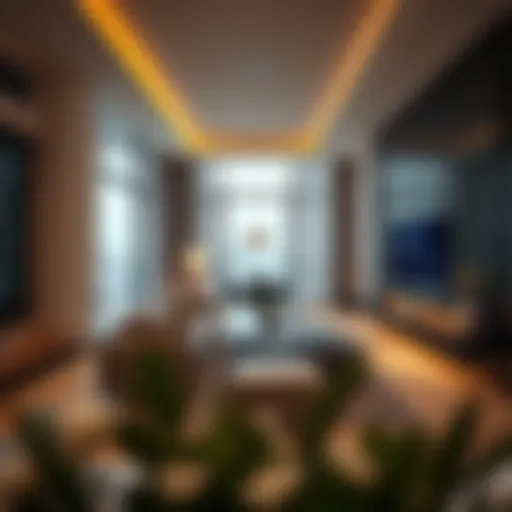The Modern Majlis: Blending Tradition with Today
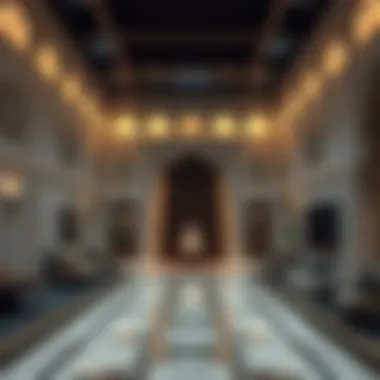

Intro
The majlis, a cornerstone of Gulf culture, has traditionally served as a gathering place for community and hospitality. In recent years, particularly within the thriving hub of Dubai, this space has undergone a remarkable transformation, effectively blending age-old customs with contemporary design elements. This article peels back the layers of the modern majlis, examining its evolution, current trends, and significance in today’s urban landscape.
As we embark on this journey, we’ll delve into the latest market trends in real estate, how economic shifts influence property prices, and the essence of the majlis in fostering community ties. Our exploration includes practical investment strategies, especially catering to those stepping into the real estate arena for the first time. The discussion will not only highlight artistic innovations but will also provide valuable insights for investors, homeowners, and real estate agents keenly interested in this fusion of tradition and modernity.
Join us as we uncover the insights of modern majlis, discovering how these spaces are breathing new life into both residential and commercial properties across the Gulf.
Understanding the Majlis Concept
The term majlis holds a significant place in the cultural and architectural landscape of the Gulf region. It serves not only as a physical space but also as a bastion of social interaction, hospitality, and community bonding. Understanding this concept is pivotal to grasping how modern interpretations of the majlis resonate with both traditional values and contemporary living. As urban areas grow and evolve, the majlis adapts, bridging the past with current societal needs. In the context of this article, examining the majlis concept sheds light on its unique characteristics and multifaceted roles that extend beyond mere aesthetics.
Historical Origins of the Majlis
The historical roots of the majlis can be traced back centuries, where it acted as a communal area for discussion and decision-making among tribal leaders and community members. Originally, a majlis functioned as a meeting space, where issues pertinent to the tribe, clan, or even the entire community were deliberated upon. Typically, it was an open area or a room with minimal furnishings, crafted to evoke a sense of inclusion and openness.
Over time, the design of the majlis evolved, influenced by various cultural and architectural trends. The rise of the merchant class in the Gulf region saw the majlis morphing into a more embellished space, often adorned with intricate carpets, cushions, and sometimes a designated area for hospitality. In essence, this shift reflected the status of the household, indicating wealth and standing in the community. While the physical format changed, the underlying principle of fostering dialogue and connection among individuals remained constant.
Cultural Significance in Gulf Societies
In the Gulf region, the majlis is much more than just a gathering space; it is a cultural institution. It serves as a nexus for social interactions, a platform where relationships are forged, and networks are built.
- Connection to Traditions: The majlis embodies values such as hospitality and communal support, deeply entrenched in Gulf societies. It reminds the residents of their heritage, providing a space to share stories, customs, and lessons from the past.
- Role in Social Norms: In many instances, the majlis is a neutral ground for both men and women, albeit often in separate settings. This separation illustrates the cultural dynamics and allows for discussions pertinent to different segments of the society.
- Political Implications: Traditionally, the majlis has also served as a political forum. Leaders often engage with their constituents here, seeking feedback and encouraging civic participation in community matters. Thus, it plays an integral part in shaping governance and societal expectations.
"The majlis is not only about gathering; it is a ritual of togetherness that shapes the very fabric of Gulf life."
The majlis is a vessel for social customs, an embodiment of respect, and an avenue for cultural expression. Understanding these aspects is crucial when examining its transition into modern designs and uses, seamlessly integrating past traditions within contemporary contexts.
The Transition to Modernity
The majlis has always been a cornerstone of Gulf culture, serving as a space for discussion, reflection, and connection among people. However, as societies evolve, so does the majlis, transitioning from its traditional roots to embrace modernity. This transition is not merely about updating aesthetics; it encompasses a broader cultural shift that reflects societal needs, technological advancements, and evolving lifestyles.
Understanding this transition is pivotal for several reasons. Firstly, it highlights how cultural spaces adapt to contemporary demands, ensuring they remain relevant in an ever-changing world. Secondly, it provides insight into the design principles that can enhance community interaction while still preserving historical significance. Finally, this transition reveals the nuanced relationship between tradition and modern interpretation, allowing for a rich dialogue within diverse audiences—be it investors, homeowners, or simply enthusiasts of architectural evolution.
Defining Characteristics of Modern Majlis
A modern majlis isn’t just an upgrade of its predecessor; it embodies a thoughtful blend of functionality and aesthetic appeal. Some defining characteristics include:
- Open Spaces: Modern majlis designs often prioritize open layouts, fostering an inviting environment that encourages interaction. This openness allows natural light to filter in, creating a calming atmosphere.
- Multipurpose Furniture: With flexibility in mind, furniture choices have shifted towards pieces that serve multiple functions. Folding tables, stackable seating, and storage-integrated sofas enhance usability for various occasions—be it a quiet afternoon tea or a bustling family gathering.
- Technological Integration: Today’s majlis features technology seamlessly woven into its design. Smart systems for lighting and climate control, as well as integrated audiovisual setups, enhance versatility while maintaining style.
Infusion of Contemporary Design Elements
The infusion of contemporary design elements into the majlis is where tradition meets innovation. This integration can be observed in:
- Material Palette: There’s a growing trend towards using sustainable materials like bamboo, recycled metals, and eco-friendly textiles, demonstrating consideration for the environment while maintaining elegance.
- Color Schemes: In contrast to traditional, vibrant colors, modern majlis often adopts neutral tones mixed with occasional bold accents. This shift creates a sophisticated feel, making the space adaptable to personal preferences.
- Artistic Touches: Contemporary art pieces or local crafts can accentuate the majlis’s character. Incorporating art not only supports local artisans but also ties the majlis more closely to its cultural roots in an innovative way.
"In a modern majlis, every element tells a story, blending the past and future seamlessly."
By embracing these characteristics, the modern majlis reaffirms its role as more than just a room; it becomes a dynamic space where social connections and traditions flourish, curated to meet the expectations of today’s society while paying homage to its legacy.
Architectural Innovations in Modern Majlis
The modern majlis fuses traditional elements with contemporary architectural practices, creating spaces that not only honor cultural heritage but also embrace the ever-evolving demands of today's society. This blend of tradition and modernity enhances the functionality and aesthetic appeal of these gathering spaces, making them integral to both residential and commercial properties in the Gulf region.
One key aspect of this architectural innovation is the use of sustainable materials and practices. As environmental awareness grows, the building industry increasingly prioritizes eco-friendly solutions. Materials such as recycled steel, reclaimed wood, and low-impact finishes are becoming staple choices in the design of modern majlis. Employing these resources not only reduces the ecological footprint but also can result in cost savings over time. The notion of sustainability resonates deeply in Gulf societies, where preserving nature aligns with cultural values.
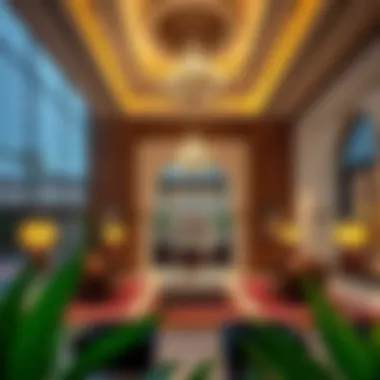

Sustainable Materials and Practices
Sustainable architecture is not merely a trend; it is an essential facet of responsible design in the context of the modern majlis. The use of materials with a lower environmental impact reflects a commitment to the community and future generations. Here are some commonly used sustainable practices:
- Local Sourcing: By utilizing locally sourced materials, architects support regional economies and reduce transportation emissions. This approach also ensures that the materials are suitable for the climate and landscape of the area.
- Passive Design Strategies: Modern majlis often incorporate passive design techniques, such as proper orientation and window placement, to maximize natural light and ventilation. This can lead to reduced energy consumption, providing comfort without relying heavily on artificial systems.
- Water Conservation: The contemporary majlis can incorporate smart water management systems. Rainwater harvesting and low-flow fixtures help conserve water, addressing a vital concern in arid climates.
Employing these strategies not only contributes to sustainability but also enhances the overall ambiance of the majlis, fostering a sense of belonging and community among users.
Integration of Technology
Another significant innovation in the modern majlis is the integration of technology. As technology permeates every aspect of our lives, its seamless incorporation into architectural design is transforming the way people interact with their spaces. This includes:
- Smart Home Features: Modern majlis can feature smart home technology, allowing users to control lighting, temperature, and security with ease. This convenience elevates the experience of gathering by creating a comfortable atmosphere.
- Audio-Visual Systems: High-quality audio-visual setups for presentations or entertainment purposes are increasingly common. This enables the majlis to serve multifunctional roles, from a place of gathering to a venue for business discussions or social events.
- Interactive Elements: Augmented reality (AR) and virtual reality (VR) technologies can be integrated to enhance the majlis experience. For instance, AR applications can provide information about the history and significance of the space, bridging the gap between past and present.
In essence, the architectural innovations shaping modern majlis are not merely cosmetic; they reflect a deep understanding of the community's evolving needs while respecting traditional values. The combination of sustainable materials and cutting-edge technology allows for a space that harmonizes with its cultural roots while catering to modern lifestyles.
"As we reimagine the majlis, we create not just spaces for gathering, but environments for cultural exchange and continuity, ensuring the majlis remains a core part of our evolving identity."
These considerations signal a promising future for the modern majlis, where innovation meets tradition, resulting in living spaces that embody the best of both worlds.
Multifunctional Uses of Modern Majlis
The modern majlis has evolved significantly, taking on various roles that extend beyond its traditional roots. The versatility of this gathering space has become increasingly apparent in contemporary settings, where social interactions, business transactions, and cultural celebrations converge. Understanding the multifunctional uses of the modern majlis can unlock insights into its relevance in today's fast-paced society and the ways it serves community and individual needs alike.
Social Gatherings and Community Events
At its core, the majlis has always been a cornerstone of social interaction in Gulf cultures. Today, it continues to serve as a hub for family get-togethers, barbeques, and cozy evening chats. It provides a space where people can unwind, share stories, and foster relationships. In an age where digital communication often outweighs face-to-face interaction, the majlis stands as a bastion of personal connection.
Nevertheless, its role in community events has expanded. From organizing book clubs to hosting cultural film screenings, modern majlis designs can accommodate diverse activities that cater to various interests. With its open layout and inviting atmosphere, the majlis fosters connectivity, allowing neighbors to come together and break bread. This aspect highlights the importance of community cohesion, making the majlis not only a familial space but a communal one.
"The majlis symbolizes unity in diversity, bringing together individuals across social strata and fostering ongoing dialogues."
Business Meetings and Networking
In addition to its social functions, the modern majlis is becoming a notable venue for professional interactions. As workplaces evolve and remote work becomes more common, traditional boardrooms may not always be the preferred setting for discussions. The modern majlis, with its blend of comfort and professionalism, offers an alternative where business meetings can take on a more relaxed, yet effective tone.
This setting is advantageous for both startups and established corporations aiming to build relationships. The aesthetic appeal of a well-designed majlis can set the mood, making clients feel at ease while facilitating open dialogue. Private nooks can allow for side discussions, while the overall ambiance encourages collaboration. Businesses increasingly see the majlis as a strategic asset, steering conversations toward innovation and partnership.
Cultural Celebrations and Traditions
Cultural identity is woven into the fabric of the majlis, which makes it a fitting venue for traditional celebrations. Be it Eid gatherings, wedding receptions, or Ramadan iftars, the majlis can easily be transformed to accommodate diverse cultural practices. This adaptability not only respects the heritage but also reinforces cultural continuity amid a modern landscape.
The design of a modern majlis often includes features that highlight cultural motifs, creating a serene ambiance that reflects the celebrations taking place within. The richness of the event is emphasized through decoration and seating arrangements that cater to guest comfort and traditional practices. Thus, the majlis becomes a conduit for passing down customs from one generation to the next, reinforcing community identity while offering space for both personal and communal joy.
Designing the Perfect Modern Majlis
Designing a modern majlis is vital in bridging the gap between traditional values and contemporary lifestyles. It reflects not just the local customs but also adapts to the changing dynamics of everyday life. A well-thought-out majlis can serve multiple purposes, from hosting guests to engaging in casual conversations or even conducting business discussions. The aesthetic and functional aspects of the majlis work in tandem to create an inviting space that encourages interaction and fosters community ties.
The modern majlis should harmoniously blend cultural motifs with up-to-date design principles. Consideration of spaciousness, comfort, and sustainability are key factors in achieving this balance. Investors or homeowners seeking to integrate a modern majlis should aim to maximize the area while ensuring it remains cozy and welcoming.
Key Design Principles
Designing a modern majlis involves adhering to certain principles that cater to both form and function. Here are some principles to bear in mind:
- Spacious Layout: Ensure an open layout that promotes conversation without barriers. Moveable furniture can adapt to different group sizes and activities.
- Natural Light: Use large windows or skylights to invite natural light, making the space lively and energetic. Sunlight can significantly improve the atmosphere of gatherings.
- Cultural Elements: Infusing traditional motifs, such as geometric patterns or Arabesques, adds an authentic feel while keeping the design fresh.
- Material Choices: Opt for durable materials that withstand wear and tear, such as high-quality wood or stone. Sustainability is increasingly important, so consider eco-friendly options.
- Comfort and Ergonomics: Seating should accommodate relaxation as well as social interactions. Plump cushions and rugs enhance comfort and invite long conversations.
Incorporating these principles can create a majlis that respects its roots while also resonating with modern tastes.
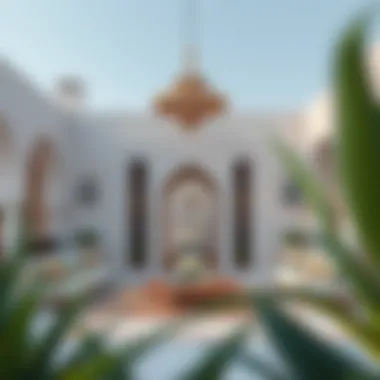

Creating an Inviting Atmosphere
An inviting atmosphere can transform a simple gathering into a memorable event. Here are some strategies to craft that welcoming vibe:
- Warm Color Palettes: Utilize earth tones mixed with vibrant colors to create warmth and comfort. Colors like terracotta, rich greens, or deep blues encourage a relaxed ambiance.
- Acoustic Treatments: Consider soft furnishings that absorb sound, creating a quieter space ideal for conversations. This helps maintain privacy and enhances intimacy during gatherings.
- Cultural Artifacts: Displaying local art or handcrafted items can serve as a conversation starter. It instills pride and appreciation for local crafts, enriching the experience for guests.
- Lighting Layers: Incorporate various lighting sources, like sconces, floor lamps, and dimmable fixtures, that can adjust based on the time of day and mood of the gathering. Soft lighting can make a drastic difference, adding to a cozy feel.
- Integrated Technology: While maintaining the essence of a majlis, technology like smart TVs or sound systems for background music can enhance the experience without overpowering the environment.
By implementing these techniques, the modern majlis can become a serene haven that embodies hospitality and tradition, providing a warm embrace for every visitor.
The Role of the Modern Majlis in Dubai Real Estate
The modern majlis plays a pivotal role in the real estate landscape of Dubai, serving as more than just a gathering space; it has evolved into a critical component of residential and commercial architecture. This integration of modern majlis into properties reflects a broader cultural shift, embracing both tradition and contemporary living. For investors and homeowners, understanding this fusion is essential not only for aesthetic appreciation but also for making informed decisions in the ever-changing real estate market.
Market Trends Influencing Design
In recent years, the design of modern majlis has been influenced by several market trends. First and foremost, there is a growing preference for multifunctional spaces. Homebuyers, especially those in urban environments, are seeking areas that can serve various purposes, from casual family gatherings to formal functions. This shift drives architects and designers to innovate further, fusing traditional majlis elements like plush seating and intricate decorative motifs with contemporary features such as open layouts and natural lighting.
Additionally, sustainability has made its mark on the modern majlis. Many new developments incorporate eco-friendly materials and energy-efficient design, resonating well with a populace increasingly concerned about the environment. Utilizing materials like reclaimed wood or sustainable fabrics brings a sense of authenticity while being mindful of ecological impact. This not only enhances the property’s value but also aligns with the values of environmentally conscious buyers.
Furthermore, technology integration is reshaping how majlis spaces are designed and used. With smart home devices becoming more common, potential buyers are keen on spaces that facilitate seamless technology integration—think ambient lighting, temperature control, and even sound systems that can be easily controlled with a smartphone.
Factors like these not only reflect changing consumer preferences but also signify the importance of modern majlis in showcasing a property's ability to adapt to contemporary living standards.
Investor Interest and Property Value
The presence of a stylish, well-designed modern majlis can significantly influence property values in Dubai's competitive market. Investors recognize that a high-quality majlis enhances the appeal of a home, particularly to expatriates and affluent locals who often prioritize social spaces in their living arrangements.
For instance, properties featuring modern majlis often see a higher return on investment due to their elevated status and appeal. Exclusive residential developments, such as those found in the Palm Jumeirah or Downtown Dubai, have embraced this trend, integrating majlis into their designs to cater to the luxury market. Investors are increasingly prioritizing characteristics that blend traditional hospitality with cutting-edge design, which reflects a deeper understanding of local culture while meeting global standards.
Moreover, properties showcasing an elegant modern majlis often attract premium rental prices, benefiting investors seeking to capitalize on the short-term rental market. Properties marketed towards both leisure travelers and business professionals stand to gain from the communal and conversational aspect that a well-appointed majlis offers, thus appealing to wider demographics.
Overall, as the majlis continues to take shape in modern contexts, its role as a cultural symbol intertwined with value enhancement cannot be overstated. Understanding its implications in Dubai's real estate market is essential for anyone looking to navigate these waters successfully.
Case Studies of Iconic Modern Majlis
Exploring case studies of iconic modern majlis serves as a crucial element in understanding the blending of traditional elements with contemporary living. These examples provide a lens through which we can evaluate not just architectural trends, but also social dynamics and cultural expressions. As investors or homebuyers search for properties that resonate with local heritage while offering modern amenities, these case studies illuminate the values and preferences of Gulf societies today.
Prominent Residential Examples
In recent years, several residential properties have come to be renowned for their stunning modern majlis. For instance, the Majlis at the Emirates Hills showcases a spectacular integration of spaces designed for welcoming guests, underscoring hospitality while reflecting the region's rich cultural roots. The majlis is adorned with intricate Arabic calligraphy and features vibrant colors that marry both tradition and modernity.
Another example can be found in The Palm Jumeirah, where villas incorporate elegant majlis areas that serve as focal points. These spaces are often designed to offer breathtaking views of the water, fostering a serene environment for social interaction and relaxation. The use of contemporary furnishings combined with traditional patterns in textiles shows a conscious effort to honor cultural legacy while embracing today's design sensibilities.
These residential examples are not just houses; they represent lifestyle choices that connect the past and present. The layout, where majlis holds a central role, encourages community interaction, making these spaces cherished within Gulf homes. Investors should recognize these attributes as essential selling points when assessing property value.
Innovative Public Spaces
Public spaces with modern majlis designs are popping up across the region, mimicking the traditional concept in ways that appeal to contemporary lifestyles. One noteworthy public majlis is found in Sharjah’s Al Qasba, where open-air seating areas are set amidst cultural attractions. This setup allows residents and visitors alike to engage in social dialogue while surrounded by art and community gatherings.
Similarly, Abu Dhabi’s Corniche features public majlis with a focus on sustainability. Here, modern materials and eco-friendly practices come into play, making these spaces not only visually appealing but environmentally conscious too. These public majlis are adorned with greenery and water features, offering an alluring atmosphere for relaxation, socializing, and cultural events.
"The modern majlis is a bridge connecting cultures and social settings, allowing for dynamic interactions in a rapidly changing environment."
These innovative public spaces play a vital role in community cohesion. By serving as venues for cultural events, exhibitions, and gatherings, they enrich the urban fabric while enhancing local identity. Investors in public infrastructure should emphasize the societal benefits of modern majlis layouts and their ability to cultivate connections among diverse groups.
Overall, the case studies of these iconic modern majlis not only highlight architectural ingenuity but also reflect a deeper narrative of community values and cultural persistence in evolving urban landscapes.
Challenges in Modern Majlis Integration
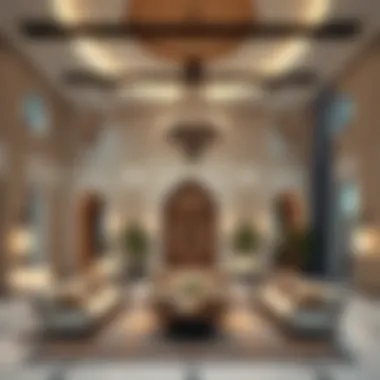

The integration of the modern majlis into contemporary living presents a complex interplay of tradition and modernity. This section addresses the key challenges faced by designers, homeowners, and communities as they navigate the balancing act between preserving cultural heritage and catering to modern needs. Understanding these challenges is crucial for investors and stakeholders looking to engage with this evolving aspect of Gulf architecture, ensuring the majlis remains relevant and vibrant in a fast-changing urban landscape.
Balancing Tradition with Modern Needs
Striking a chord between the esteemed traditions of the majlis and the demands of modern life requires thoughtful consideration. The majlis historically served as a gathering place for social interaction, hospitality, and community bonding. Yet, with the hustle of contemporary lifestyles, many seek spaces that cater not only to tradition but also to modern functionalities, such as technology integration and flexible layouts.
In practical terms, this balance can manifest in several ways:
- Design Elements: Incorporating traditional motifs and materials with modern architectural approaches. For instance, using local stone or wood in sleek designs that offer an inviting yet minimalist appearance.
- Functionality: Customizing spaces to accommodate varying uses—from formal gatherings to casual family get-togethers—without losing the essence of the majlis.
- Technological Presence: Integrating smart technology for lighting and sound systems that enhance the experience within the majlis, allowing it to serve a dual function as a contemporary space while respecting its roots.
Designers often rely on a keen understanding of cultural nuances alongside modern aesthetics to create a joint identity, resulting in spaces that engage users while echoing their rich heritage.
Catering to Diverse Audiences
The majlis has transcended its role strictly as a cultural symbol; today, it caters to an increasingly diverse audience. This evolution stems from the multicultural tapestry of Gulf societies, with inhabitants from various backgrounds seeking a sense of belonging.
Catering to various needs involves:
- Inclusivity in Design: Ensuring the majlis is accessible and welcoming to all, including women, youth, and expatriates. This may mean redesigning layout aspects or providing facilities that encourage broader participation in community events.
- Community Programs: Organizing diverse activities that appeal to multiple demographics fosters engagement. Events may range from traditional storytelling sessions to modern art exhibitions, providing relevance to both older generations and contemporary youth.
- Cultural Sensitivity: While modernity is key to attracting younger residents, it's crucial that design choices remain sensitive to cultural logistics, maintaining an atmosphere that respects traditional values.
Integrating diverse needs into the majlis enhances its role as a communal hub, further solidifying its place in the heart of modern Gulf societies.
As we delve into the last sections of this narrative, the challenges faced in modern majlis integration highlight both obstacles and opportunities, paving the way for a rejuvenated cultural landmark in an ever-evolving world.
Future Prospects for the Modern Majlis
The modern majlis is poised for a transformative journey as it forges its way into the future, addressing the needs and expectations of contemporary society while honoring its cultural roots. This half-tent, half-house fixture is much more than just a room; it symbolizes the values of hospitality, community, and tradition in the Gulf region. Its evolution carries significant implications not just for design but also for social interactions, cultural identity, and even real estate markets.
Evolving Design Trends
As the aesthetics of the majlis meld with modern sensibilities, we see exciting design trends emerging. Homeowners and architects alike are embracing an array of influences that reflect a convergence of the old and the new. Here are a few emerging trends in the design of modern majlis:
- Open Concept Layouts: Unlike their traditional counterparts which often had segmented spaces, modern majlis are leaning towards open spaces that encourage fluidity and connection among guests.
- Sustainable Innovations: Eco-friendly materials are being used significantly—reclaimed wood, natural stone, and sustainable fabrics. This not only sways toward modern environmental consciousness but maintains the rich texture associated with traditional design.
- Incorporation of Technology: Imagine a majlis equipped with smart lighting that can adjust the ambiance at the click of a button. This integration of technology improves functionality while retaining the essence of social gatherings.
- Fusion of Styles: The modern majlis often showcases a blend of international aesthetics—think contemporary furniture from Scandinavian design mingling with traditional Middle Eastern textiles. This melting pot approach supports a narrative of global interconnectedness, appealing to diverse tastes.
"The modern majlis encapsulates a dialogue between past and present, catering to a global society while staying true to its roots."
These trends are not merely aesthetic choices; they reflect broader societal changes, highlighting the majlis's role as a cultural hub and a space for evolving community interactions.
The Majlis as a Cultural Symbol
The majlis is a living testament to the traditional values of hospitality and community bonding. As it transitions into modernity, it also holds a critical cultural significance that is deeply embedded in the fabric of Gulf societies. The future prospects of the majlis are not only about structural design; they are also about preserving and celebrating cultural identity in a rapidly globalizing world.
- Maintaining Cultural Continuity: As the majlis adapts, it maintains an underlying cultural narrative that connects generations. Future prospects involve ensuring that younger generations appreciate the majlis's role in fostering familial and communal relationships. For instance, integrating educational programs that highlight the majlis's historical significance could bridge knowledge gaps.
- Adaptation to Diverse Audiences: The modern majlis offers flexibility to cater to varied groups—whether it's a gathering for local artisans or an event showcasing multicultural talent. Its design and function should reflect this adaptability, promoting inclusivity while upholding traditional values.
- Symbol of Community Resilience: In challenging times, such as economic downturns or social strife, the majlis can serve as a rallying point for community solidarity. Its presence becomes a reminder of cultural heritage and collective resilience.
For further reading on the cultural framework surrounding the majlis, you can explore resources like Britannica, and for architectural insights visit ArchDaily or Dezeen.
Closure: The Ongoing Legacy of the Majlis
The modern majlis holds a crucial place not only in the architectural landscape but also within the heart of cultural expression in Gulf societies. This traditional space, once strictly a gathering point for community discussions and familial connections, has seamlessly evolved to incorporate contemporary living principles while still celebrating its roots. The importance of this transformation underscores an enduring legacy that marries past and present.
Cultural Reflections in Modern Architecture
In exploring the modern majlis, one can see how it reflects broader trends in architecture that grapple with globalization and local identity. As the Gulf region becomes a melting pot of cultures, the majlis stands as a testament to the ability to adapt without losing the essence of community and tradition.
- Incorporation of Local Materials: Many modern designs prioritize sustainable, locally-sourced materials—like palm wood or natural stones—to preserve a connection to the landscape.
- Architectural Inspirations: Influences from international design can be seen; yet, they are often blended with traditional elements, creating a unique aesthetic that showcases the cultural heritage.
"A home is not just a dwelling but a story. The majlis partakes in that story, allowing both tradition and modernity to converse."
The Enduring Importance of Social Spaces
The social relevance of the majlis cannot be overstated. In an era where digital interactions often overshadow physical gatherings, the majlis provides a sanctuary for face-to-face communication and community bonding. This is particularly significant for:
- Maintaining Cultural Practices: It fosters the passing down of customs, ensuring they aren't lost in the shuffle of modernization.
- Building Networks: For many, it's a pivotal point for business discussions and community events, highlighting its multifunctional aspect.
- Social Cohesion: The majlis brings together diverse groups, encouraging dialogue and understanding across various backgrounds.

